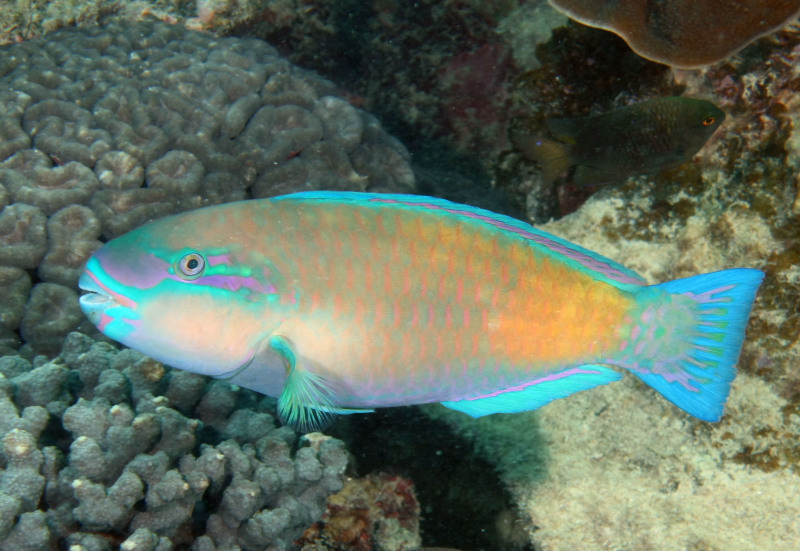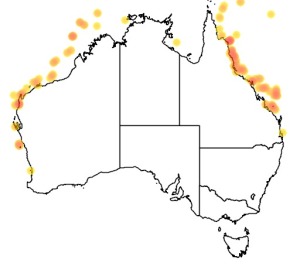Colours
Distinguishing features
A small to medium sized parrotfish that can have considerable colour variation. Terminal phase males are generally lime-green with a yellowish patch toward the tail. The dorsal, ventral and tail fins are blue, while the pectoral fin is green with a thin purple stripe. The scales are edged with purple. The fish can however darken its colour to a brownish-green from time to time (see image below). The initial phase fish are generally dark maroon-brown with pink around the lips, and often with a double row of 4 white spots along the side. These fish can too change colour, with a lighter colour pattern frequently seen in the larger IP fish. The juvenile is dark brown with a series of horizontal white stripes
Size
- Up to 40 cm (Standard length)
Depth range
- Depth range data is not yet available.
Synonyms
Similar taxa
-
Animalia:
Greenfin Parrotfish (species: Chlorurus spilurus)
Prof Kendall Clements (U Auckland) has advised that Chlorurus sordidus is found only in the Indian Ocean. Specimens from the Pacific Ocean are now referred to Chlorurus spilurus, which has been revived from the synonymy of Chlorurus sordidus.
Distribution
Distribution and habitat preferences
Possibly the most common Scarid at Lizard Island, it is found in nearly all habitats, but most common on shallow flats and lagoonal and backreef patch reefs.
Found in most locations around the Island.
Behaviour
The Greenfin Parrotfish, along with others from the genus Chlorurus, have exposed teeth in powerful jaws, and they use an excavating mode of feeding. They take benthic turf algae from dead coral surfaces, and due to their high numbers are considered important agents of bioerosion. Spawning takes place in the summer months at reef passes and points with good water flow. This species reaches 8-9 years of age, with both males and females present in the initial phase, but only males in the green terminal phase. There are strong differences in the demography of this species between Lizard Island and the outer barrier reef. Population density at Lizard is 50% lower than at the outer barrier, however fish at Lizard grow faster, live longer, and suffer less mortality.
Web resources
References
- Allen and M.V. Erdmann, G.R. (2012). Reef fishes of the East Indies. Volumes I-III in: Reef fishes of the East Indies. Tropical Reef Research, Perth, Australia. LIRS catalog number 90162.
- Bay, L.K., J.H. Choat, L. van Herwerden and D.R. Robertson (2004). High genetic diversities and complex genetic structure in an Indo-Pacific tropical reef fish (Chlorurus sordidus): evidence of an unstable evolutionary past? Marine Biology, 144: 757-767. LIRS catalog number 849.
- Bellwood, D.R. (1985). The functional morphology, systematics and behavioural ecology of parrotfishes (Family Scaridae), Ph.D. thesis, James Cook University, Townsville. LIRS catalog number 310.
- View all references







